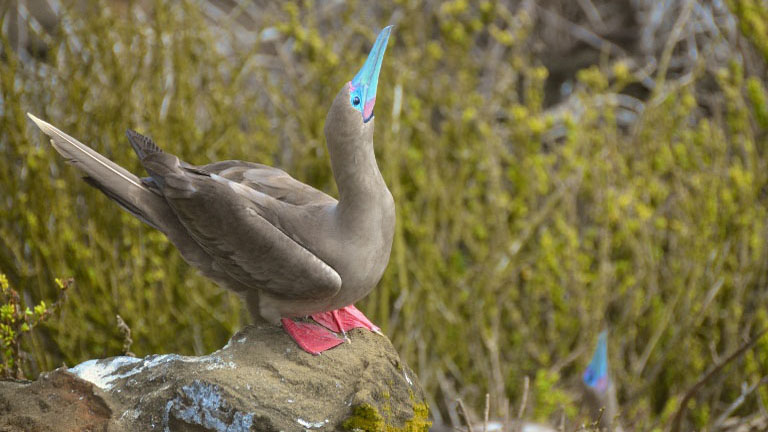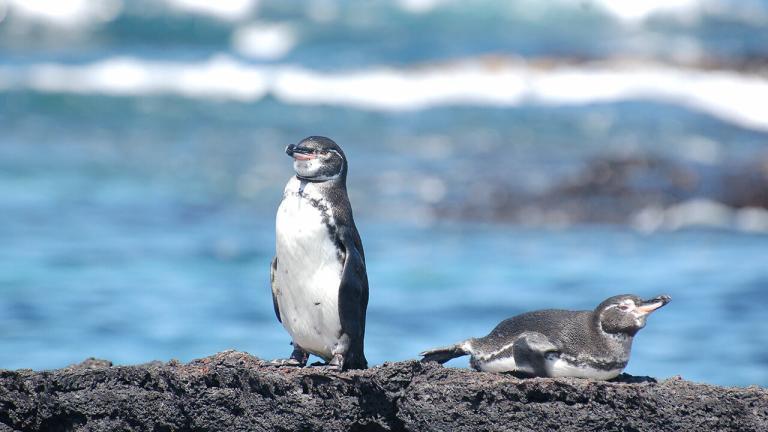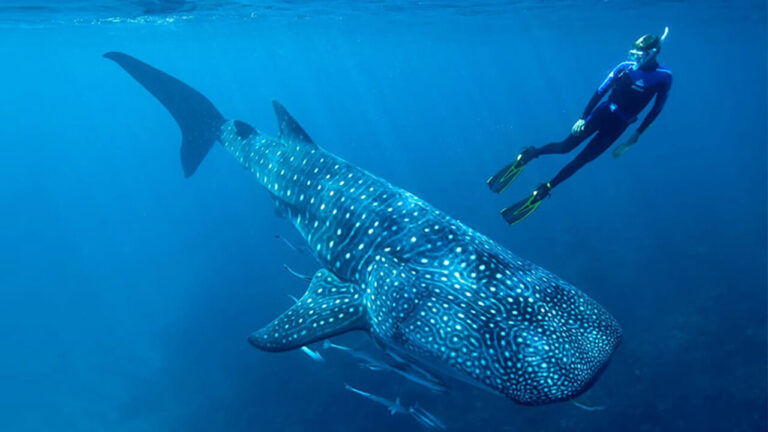What Makes the Galapagos Islands SO GREAT. 4 Reasons

[:en]The Galapagos Islands have long held a fascination for travelers around the world. There's something mysterious and unique about the destination. Between the creatures, history and natural features—there are numerous reasons the Galapagos Islands are so great.[:es]Las Islas Galápagos han mantenido durante mucho tiempo una fascinación para los viajeros de todo el mundo. Hay algo misterioso y único en el destino. Entre las criaturas, la historia y las características naturales, existen numerosas razones por las que las Islas Galápagos son tan geniales.[:]
[:en]
Reason #1: The Islands
The Galapagos are made up of 21 islands, 18 of them major. There are also 107 islets and rocks that are beautiful for people cruising the waters.
Each island has an incredible landscape and story. People will learn that Floreana has the most interesting human history while San Cristobal has the largest freshwater lake. Other fascinating facts include:
- Marchena Island is home to the Marchena lava lizard, which is endemic
- Genovesa Island is known as the “bird island”
- Bartolome Island is one of the younger islands
- South Plaza has a unique color and landscape from the other islands
- Wolf Island is the only island that the famous vampire finch calls home
- Nameless Island is the hot spot for scuba divers
- Baltra Island was formed by a geological uplift and is very arid
The landscapes alone are awarded as a reason to visit the archipelago. However, the best way to learn more about the Galapagos and experience it is to go!
Reason #2: The Unique Wildlife
A majority of the species found in the Galapagos are endemic, which means they adapt to the changing environment. They evolve and change. As a result, there are species here that you can’t find anywhere else in the world.
Some of these incredible species include:
- The Cormorant on Fernandina and Isabela islands, whose wingspan is one-third of the size needed in order to fly. Since the cormorant doesn’t have any natural predators on the Galapagos has adapted to the need to feed underwater, the wings have adapted for a more suitable swimming shape. There are only about 1,200 of these birds in existence on the islands.
- Red and blue-footed booby, who can reach up to 60mph when entering the water. As a result of their diving prowess and feeding, their nostrils are permanently blocked. Their mating ritual is fascinating to see, and typically, the brighter the color of their feet, the more reproductive success they’ll have.
- The Albatross, located on Española Island, have a giant wingspan and thus make great use of the wind speed to travel long distances. Being endemic to the Galapagos, their courtship rituals are one-of-a-kind, as the males perform a spectacular mating dance based on circling and bowing.
- Tortoises, who arrived from south of Chile 4-5 million years ago. Each island has a different species of turtle depending on what food was available to them.
Reason #3: A Living Laboratory of Evolution
The islands were all formed within the last 5 million years. Consequently, this means the environment has altered considerably from the mainland where many of the species arrived from. If animals didn’t adapt to the new environment, then they didn’t survive – which means evolution in the Galapagos is faster than any other place in the world.
As you may know, Charles Darwin famously created the Theory of Evolution, something scientists still study today. If you’ve never asked the question as to why the Galapagos Islands are so important regarding evolution, you should.
The quick answer is, when Charles Darwin visited and studied the Galapagos, he found a clear pattern that each island hosted similar creatures, but those creatures had adapted perfectly to their environment. The studies Darwin performed in the Galapagos Islands led to his famous book, The Origin of the Species.
Reason #4: Marine Life
Although the Galapagos Islands are by the equator, it’s home to a large multitude of marine and underwater life. This is because of the unique Humboldt Current that passes through the Galapagos and brings plankton that thrives in cold water. This provides food for larger animals.
The sights you’ll see below the surface are awe-inspiring, and can arguably make your entire experience to the Galapagos. We highly recommend snorkeling or even diving to get up close and personal to the tortoises, manta rays, sharks, and colorful fish.
Endless Reasons to Visit the Galapagos Islands
When you pause and consider it, there are endless reasons to visit the Galapagos Islands, and many of those reasons make the Galapagos a great travel destination. Adventure, mystique, entertainment, beauty and more all exist in the Galapagos. It’s a place that appeals to many, but in particular, those who love nature and unspoiled places. It’s a destination worth cruising—and one that will give you innumerable memories for a lifetime.[:es]Razón n.o 1: Las islas
Las Galápagos están formadas por 21 islas, de las cuales 18 son importantes. También hay 107 islotes y rocas que son magníficas para la gente que navega por las aguas.
Cada isla tiene un paisaje y una historia increíbles. La gente aprenderá que Floreana tiene la historia humana más interesante, mientras que San Cristóbal tiene el lago de agua dulce más grande. Otros hechos fascinantes incluyen:
- La isla Marchena es el hogar del lagarto de lava de Marchena, que es endémico.
- La isla Genovesa es conocida como la “isla de los pájaros”.
- La isla Bartolomé es una de las islas más jóvenes.
- Plaza Sur tiene un color diferente a las otras islas.
- La isla Wolf es la única a la que el famoso pinzón vampiro llama hogar.
- La Isla Sin Nombre es el lugar predilecto para los buceadores.
- La isla de Baltra fue formada por un levantamiento geológico y es muy árida.
Los paisajes por sí solos se asignan como motivo para visitar el archipiélago. Sin embargo, la mejor manera de aprender más sobre Galápagos y experimentarlo ¡es yendo!
Razón n.o 2: La vida silvestre única
La mayoría de las especies que se encuentran en Galápagos son endémicas, lo que significa que se adaptaron a los cambios del medio ambiente. Las especies evolucionan y cambian. Como resultado, hay especies aquí que no se pueden encontrar en ningún otro lugar del mundo.
Algunas de estas increíbles especies incluyen:
- El cormorán de las islas Fernandina e Isabela, cuya envergadura es un tercio del tamaño necesario para volar. Debido a que el cormorán no tiene depredadores naturales en Galápagos, ha podido adaptarse a la necesidad de alimentarse bajo el agua. Sus alas se han adaptado para una forma de nado más adecuada. Solo existen alrededor de 1200 de estas aves en las islas.
- El piquero de patas rojas y azules, que puede alcanzar hasta casi 100 km/h cuando entra al agua. Como resultado de su destreza para bucear y alimentarse, sus fosas nasales están permanentemente obstruidas. Su ritual de apareamiento es fascinante para la vista. Típicamente, cuanto más brillante es el color de sus pies, más éxito reproductivo tiene.
- El albatros, ubicado en la isla Española, tiene una envergadura tremenda y por lo tanto aprovecha la velocidad del viento para viajar largas distancias. Siendo endémico de las Galápagos, sus rituales de cortejo son únicos: los machos realizan una espectacular danza de apareamiento basada en círculos y reverencias.
- Las tortugas gigantes, que llegaron del sur de Chile hace unos 4-5 millones de años. Cada isla tiene una especie diferente de tortuga, dependiendo de la comida que tengan a su disposición.
Razón n.o 3: Un laboratorio viviente de la evolución
Todas las islas se formaron en los últimos 5 millones de años. En consecuencia, el medio ambiente se ha alterado considerablemente con respecto al del continente, de donde proceden muchas de las especies. Si los animales no se hubieran adaptado al nuevo ambiente, no habrían sobrevivido, lo que significa que la evolución en Galápagos es más rápida que en cualquier otro lugar del mundo.
Como ustedes saben, Charles Darwin creó la famosa teoría de la evolución, algo que los científicos estudian hasta el día de hoy. Si nunca te has preguntado por qué las Islas Galápagos son tan importantes con respecto a la evolución, deberías hacerlo.
La respuesta rápida es que Charles Darwin —cuando visitó y estudió las Galápagos— encontró un patrón claro en el que las islas en general albergaban criaturas similares, pero las criaturas de cada isla se habían adaptado perfectamente a su entorno. Los estudios que Darwin realizó en las Islas Galápagos llevaron a su famoso libro El origen de las especies.
Razón n.o 4: Vida marina
Aunque las Islas Galápagos están cerca de la línea ecuatorial, son el hogar de una gran multitud de vida marina y submarina. Esto se debe a la Corriente de Humboldt, que pasa a través de las Galápagos y trae plancton que prospera en agua fría. Esto proporciona alimento para los animales más grandes.
Lo que verás debajo de la superficie es impresionante y puede hacer que toda tu experiencia en las Galápagos sea una experiencia inolvidable. Recomendamos el snorkel o incluso el buceo para acercarse a las tortugas, mantarrayas, tiburones y peces de colores.
Innumerables razones para visitar las Islas Galápagos
Cuando se hace una pausa para considerarlo, hay un sinfín de razones para visitar las Islas Galápagos. Muchas de esas razones hacen de Galápagos un gran destino para viajar. Aventura, mística, entretenimiento, belleza y más, todo existe en las Galápagos. Es un lugar que atrae a muchos, pero en particular a los amantes de la naturaleza y de los lugares vírgenes. Es un destino que vale la pena navegar, un destino que te dará innumerables recuerdos para toda la vida.[:]




